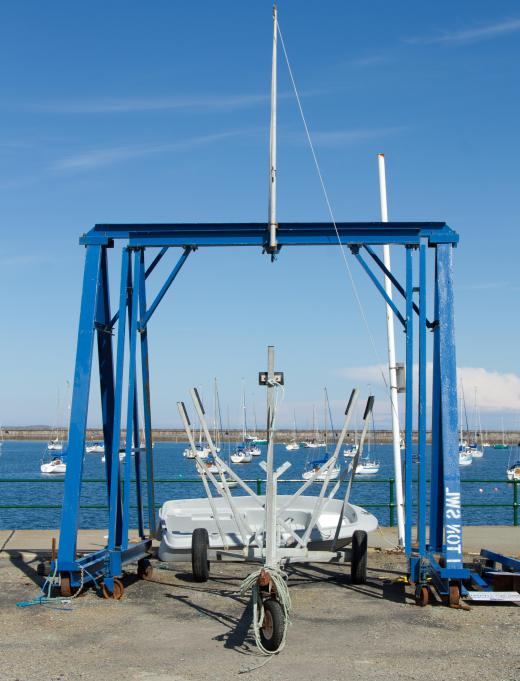A winch is a tool designed to crank or tow a line. The term “winch” classifies a tool based on how it works, but says little about the circumstances under which it may be used. Simple winches are little more than sturdy spools that users manually crank to tighten or loosen cable, rope, or cording. More complex versions are mechanical, often powered by hydraulics, gasoline-fed motors, or batteries. Winches are common in a great many contexts, from sailing and home construction projects to heavy industry, excavation, and vehicle off-roading.
There are three essential parts to any winch: a spool, a crank, and a line. The line is generally stored on the spool, and the crank is what controls what amount is let out or in, along with overall tension and release speed. Winches are most useful any time something needs to be towed, anchored, or lifted. When one end of the winch line is attached to a movable object, operating the crank will tighten the line, moving or shifting the object.

Basic winches are very common in sailing. Each of a sailboat's sails is usually connected to the vessel’s mast thorough a series of ropes, most of which are grounded on deck-mounted winches. Sailors adjust the slack in these ropes to control the direction and speed of the boat. Cranking the winches tightens the slack, while slowly releasing them loosens it. A boat winch is usually manual, but larger boats are sometimes outfitted with more powerful, mechanized versions.

Many machines used in manufacturing use industrial-grade winches that often dwarf their smaller boating counterparts. But for the basic means of their operation, they would have little in common. Large mechanical winches are particularly helpful in the operation of elevators, construction or building erection, and some aspects of fire and rescue. Almost any application where major hoisting or lifting is required can be a useful context for these tools.

Mechanical winches are often powered by hydraulics, electricity, or a combination of both. A hydraulic winch gets its energy from pressurized water chambers, while an electric winch relies on a live current. Much of how the tool is powered is a factor of circumstance as well how it is designed to be used.
Winches are also commonly used in towing, though in this context they are often motor-driven. Tow trucks are one place where the technology is particularly helpful, but self-tow scenarios, particularly in off-roading, also make ample use of winching. People who do a lot of off-road and wilderness driving often run into situations where their vehicles get stuck well out of range of ordinary highway help. If the vehicle has a mounted winch, however, there is often little in the way of a serious problem.
Mounted winches are usually professionally installed on a car’s front or rear bumper. They become permanent parts of the vehicle, but are only used when needed. Should the car become stuck, the driver need only extend the line, anchor it to something stable like a large tree, and turn the motor on. The car will then slowly move towards the anchor until all of the line has been reeled in.
